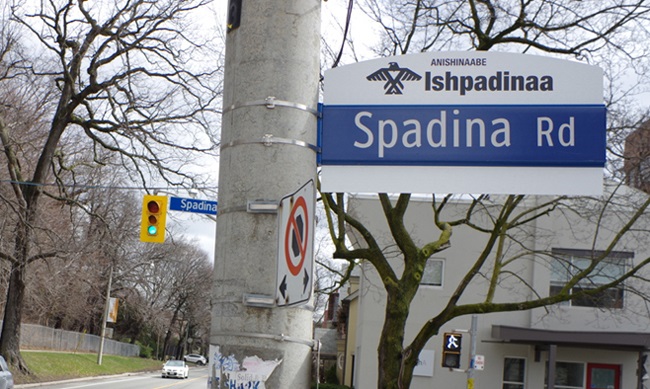Where the streets have an old name

By Rick Garrick
TORONTO—Two historic Indigenous trails in the Toronto area are marked with Anishinaabemowin signs at the corners of Spadina and Dupont, Spadina and Davenport, and Davenport and Dupont.
“The idea was to recognize the history of the area,” says Stuart Grant, a board member with the Dupont by the Castle Business Improvement Association in Toronto. “For thousands of years, First Nations people have been here, not just [two to three] hundred like European settlers have. And a lot of First Nations people are still here, so it’s a kind of recognition that this land is shared.”
Grant says Davenport and Spadina Roads were the sites of ancient trails that First Nations people used to travel back and forth in the area.
“We wanted to get people talking and encourage a bit of education around all history of the area, not just the stuff we get from the school history books,” Grant says.
Grant says the idea for the Anishinaabemowin signs was inspired by the Ogimaa Mikana Project, which was initiated in 2013 by a group of people, including Hayden King and Susan Blight. The project is an effort to restore Anishinaabemowin place names to the streets, avenues, roads, paths and trails of Gichi Kiiwenging (Toronto). It included the posting of temporary Anishinaabemowin street name stickers in Toronto and the installation of Anishinaabemowin phrases on billboards in some cities across Ontario, including Toronto, Thunder Bay, North Bay, and Peterborough.
“They still have to have the actual city [street] name, but there is room on the new signs that they are making where either a resident’s association or in our case the Business Improvement Association can use the top part of the sign for a logo or an ad,” Grant says. “So that is where they allowed us to put the Anishinaabe names up there along with a Thunderbird symbol.”
Grant says there was a good response from the community about the signs, which were installed in 2016.
“It’s been almost 100 per cent positive,” Grant says. “A lot of people liked it. It went kind of viral on social media around here. Ogimaa Mikana got comments from Ottawa and Peterborough and out west, with people saying: ‘Wow, if they can do it there, why can’t we do it in our town?’.”
Toronto City Councillor Joe Cressy says the Anishinaabemowin signs are located in an area where he grew up. He represents Ward 20 Trinity-Spadina on city council.
“We are living on colonized land, frankly, so as a way to recognize our past but also to ensure a living legacy continues, we partnered with the local businesses and Ogimaa Mikana to transform local street signs to respect their original Anishinaabe name,” Cressy says. “People are just thrilled. We’re looking to do this throughout and across Toronto, and frankly the feedback I hear from neighbours and residents is that this is a part of our history that far too many people don’t know about. We’ve tried to hide or by design obliterate it in the past, and it’s time to remember it properly.”
Toronto also has numerous plaques that describe the First Nations history of sites at various locations across the city. The plaques are posted online.


